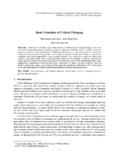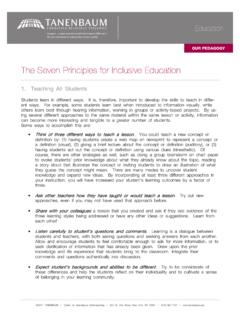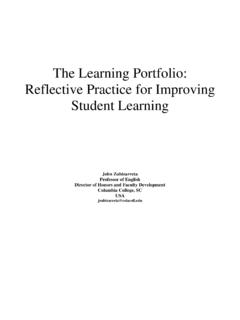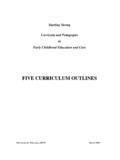Transcription of Developing higher level thinking - AABRI
1 Journal of Instructional Pedagogies Developing higher level thinking , Page 1 Developing higher level thinking Barbara Limbach Chadron State College Wendy Waugh Chadron State College Abstract This paper identifies an interdisciplinary, five-step process, built upon existing theory and best practices in cognitive development, effective learning environments, and outcomes-based assessment. The Process for the Development of higher level thinking Skills provides teachers with an easy to implement method of moving toward a more purposeful and active-learning environment, which encourages higher level thinking . Keywords: critical thinking , higher - level thinking , active-learning, learning environments, assessment Introduction pedagogy is a word that describes the art ofbetter and to perfect the art (Queensland Government, 2002)study of teaching methods, which includes the stumay be achieved. One of the most commonskills in students (Halpern, 1999).
2 And achieve intellectual freedom. thinking is the cognitive process world; questioning everyday assumptions will direct students to new solutions that can positively impact the quality of their lives. Tart of teaching to a pedagogical process that can level thinking skills deemed necessary for a quality lifeActive learning can make amost importantly, can cause students to thinkmust give up the belief that students "covers it". While students may gain some exposure to material through preoverview lectures, true understanding of the material takes place when they are actively involved with and reflect on the meaning of what they are authors propose the following fiveThinking Skills, can be implemented in virtually any teaching or training setting to active learning environment and to Figure 1: Process for the Development of higher level thinking Skills 4. Review, Refine, and ImproveJournal of Instructional Pedagogies Developing higher level Thinkingdescribes the art of teaching.
3 Most teachers strive(Queensland Government, 2002). A strong pedagogy necessitates the tudy of teaching methods, which includes the study of specific ways in which teaching goals be achieved. One of the most common goals of teaching is to develop critical thinking (Halpern, 1999). This higher level thinking is what allows students to excel achieve intellectual freedom. thinking is the cognitive process used to make sense of world; questioning everyday assumptions will direct students to new solutions that can positively . The purpose of this paper is to introduce those interested in the al process that can be utilized to develop in students thdeemed necessary for a quality life. Active learning can make a course more enjoyable for both teachers and studuse students to think at a higher level . For this to happen, educators must give up the belief that students will be unable to learn the subject at hand unless the teacher "covers it". While students may gain some exposure to material through pre-class readings and lectures, true understanding of the material takes place when they are actively involved with and reflect on the meaning of what they are doing.
4 Following five-step Process for the Development of higher implemented in virtually any teaching or training setting to active learning environment and to move learners toward higher level thinking . Figure 1: Process for the Development of higher level thinking Skills 1. Determine Learning Objectives2. Teach Through Questioning3. Practice Before Assessment4. Review, Refine, and Improve5. Provide Feedback & Assessment of LearningJournal of Instructional Pedagogies Developing higher level thinking , Page 2 strive to become A strong pedagogy necessitates the teaching goals critical thinking students to excel to make sense of the world; questioning everyday assumptions will direct students to new solutions that can positively interested in the in students the higher course more enjoyable for both teachers and students, and . For this to happen, educators learn the subject at hand unless the teacher class readings and lectures, true understanding of the material takes place when they are actively involved for the Development of higher level implemented in virtually any teaching or training setting to create a more Step One: Determine Learning Objectives Considering the importance of a course, its placement in a program, and its role in providing a base of knowledge, a teacher should carefully identify key learning objectives that recognize what students should know when they exit the happen, these learning objectives, as well as the activities and assessments, must require students to perform and demonstrate higher level thinking .
5 Thus, a wella specific behavior, introduce and practice the desired behavior, and end with the learner exhibition of the behavioral response. The development of wellaccelerate a learner's movement into higher level Figure 2: Step One: Determine Learning Objectives A well-written objective should include a behavior that is appropriate for of the thinking . Bloom's Revised Taxonomy of cognitive objectives is useful in planning curriculum that incorporates low to high accomplishment of low level thinking the use of Bloom's Revised Taxonomystudent thinking at all levels . With the dramatic changes Taxonomy provides an even more powerful tool to fit today's teachers' needs (para. 16). The structure of the Revised Taxonomy provides a clearof the alignment between standards and educational goals, objectives, products, and activities(Krathwohl, 2002). Teachers must make difficult decisioninstructional time; Bloom's Revised Taxonomy ensures a fit between a learning objective.
6 The progressive levels of Understanding, Applying, Analyzing, Evaluating, and Creating. Students who interact in the upper three levels are practicing higher demonstrates a simple recall of informationconcepts. Applying requires the use of information in another familiar situation. requires an answer that demonstrates an ability to see patterns and concepts, and theories into component parts. 1. Determine Learning Objectives2. 3. 4. 5. Journal of Instructional Pedagogies Developing higher level ThinkingLearning Objectives Considering the importance of a course, its placement in a program, and its role in providing a base of knowledge, a teacher should carefully identify key learning objectives that recognize what students should know when they exit the class. To make higher level thinking happen, these learning objectives, as well as the activities and assessments, must require students to perform and demonstrate higher level thinking . Thus, a well-written lesson plan should target introduce and practice the desired behavior, and end with the learner exhibition of the behavioral response.
7 The development of well-written objectives will greatly accelerate a learner's movement into higher level thinking (Ball & Garton, 2005). Figure 2: Step One: Determine Learning Objectives written objective should include a behavior that is appropriate for Bloom's Revised Taxonomy of cognitive objectives is useful in planning low to high level thinking activities. The successful level thinking allows teachers to lead students to the higher levelthe use of Bloom's Revised Taxonomy (Anderson & Krathwohl, 2001) teachers can plan for With the dramatic changes in society over the last five decades, the Revised Bloom's Taxonomy provides an even more powerful tool to fit today's teachers' needs (Forehand, , . The structure of the Revised Taxonomy provides a clear, concise visual representationof the alignment between standards and educational goals, objectives, products, and activitiesmust make difficult decisions about how to use their allotted Bloom's Revised Taxonomy ensures a fit between a lesson s purpose and levels of Bloom's Revised Taxonomy include Remembering, Understanding, Applying, Analyzing, Evaluating, and Creating.)
8 Students who interact in the upper three levels are practicing higher level thinking . Remembering requires an answer that l of information. Understanding requires the explanation ofrequires the use of information in another familiar situation. hat demonstrates an ability to see patterns and to classify information, concepts, and theories into component parts. Evaluating requires the justification of a decision Consider program and course learning outcomes Define behaviors students should exhibit Target behaviors in higher level thinkingDetermine ObjectivesJournal of Instructional Pedagogies Developing higher level thinking , Page 3 Considering the importance of a course, its placement in a program, and its role in providing a base of knowledge, a teacher should carefully identify key learning objectives that class. To make higher level thinking happen, these learning objectives, as well as the activities and assessments, must require students written lesson plan should target introduce and practice the desired behavior, and end with the learner written objectives will greatly (Ball & Garton, 2005).
9 Written objective should include a behavior that is appropriate for the chosen level Bloom's Revised Taxonomy of cognitive objectives is useful in planning ccessful to lead students to the higher levels . With & Krathwohl, 2001) teachers can plan for in society over the last five decades, the Revised Bloom's Forehand, , , concise visual representation of the alignment between standards and educational goals, objectives, products, and activities about how to use their allotted lesson s purpose and include Remembering, Understanding, Applying, Analyzing, Evaluating, and Creating. Students who interact in the requires an answer that the explanation of ideas or requires the use of information in another familiar situation. Analyzing classify information, requires the justification of a decision Consider program and course learning outcomes Define behaviors students should exhibit Target behaviors in higher level thinking or course of action. Finally, Creatingviewing things (Krathwohl, 2002).
10 Step Two: Teach Through Questioning Questioning is a vital part of the teaching and learning process. The art of questioning begins with establishing what is known and allows the teacher to extend beyondideas and understandings. Clasen and Bonk (1990) posited that although many strategies exist that can impact student thinking , teacher questions have the greatest impact. They went on to indicate that the level of student thinking is direcWhen teachers plan, they must consider the purpose of each question and then develop the appropriate level and type of question to accomplish the purpose. All students need experience with higher level questioning once they become familiar with a 3: Step Two: Teach Through Questioning Questioning techniques can be usedcan be categorized in a number of different ways. One simple method is to use the general categories of convergent and divergent questions. Convergent questions seek one or more very specific correct answers, while divergent questions seek a wide variety of correct answers.














